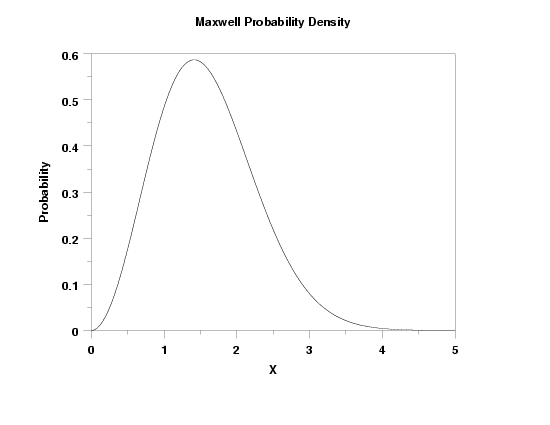

|
MAXPDFName:

 and and
 denoting the location and scale parameters, respectively.
denoting the location and scale parameters, respectively.
The case where
The Maxwell-Boltzman distribution is equivalent to the chi distribution with 3 degrees of freedom. The Maxwell-Boltzman distribution is sometimes parameterized using

In scientific applications, the
<SUBSET/EXCEPT/FOR qualification> where <x> is a variable or a parameter; <loc> is an optional number or parameter that specifies the value of the location parameter; <sigma> is an optional number or parameter that specifies the value of the scale parameter; <y> is a variable or a parameter (depending on what <x> is) where the computed Maxwell-Boltzman pdf value is stored; and where the <SUBSET/EXCEPT/FOR qualification> is optional. If <loc> and <sigma> are omitted, they default to 0 and 1, respectively.
LET Y = MAXPDF(3,0,0.3) LET Y = MAXPDF(X1,MU,SIGMA) PLOT MAXPDF(X,0,SIGMA) FOR X = 0 0.01 5
MAXWELL PROBABILITY PLOT Y MAXWELL PROBABILITY PLOT Y X MAXWELL PROBABILITY PLOT Y XLOW XHIGH MAXWELL KOLMOGOROV SMIRNOV GOODNESS OF FIT Y MAXWELL CHI-SQUARE GOODNESS OF FIT Y X MAXWELL CHI-SQUARE GOODNESS OF FIT Y XLOW XHIGH
You can use the probability plot to estimate
LET SIGMA = PPA1 LET MU = PPA0
You can obtain a maximum likelihood estimate of
This command will generate an estimate of
before the MAXWELL MAXIMUM LIKELIHOOD command. This will be used in place of the data minimum estimate of location. Uncertainty estimates can be obtained using the DISTRIBUTIONAL BOOTSTRAP command
2/2008: Corrected  to be a scale parameter rather than a shape parameter
to be a scale parameter rather than a shape parameter
Y1LABEL Probability
X1LABEL X
LABEL CASE ASIS
TITLE CASE ASIS
TITLE Maxwell Probability Density
PLOT MAXPDF(X) FOR X = 0 0.01 5

Date created: 7/28/2004 |